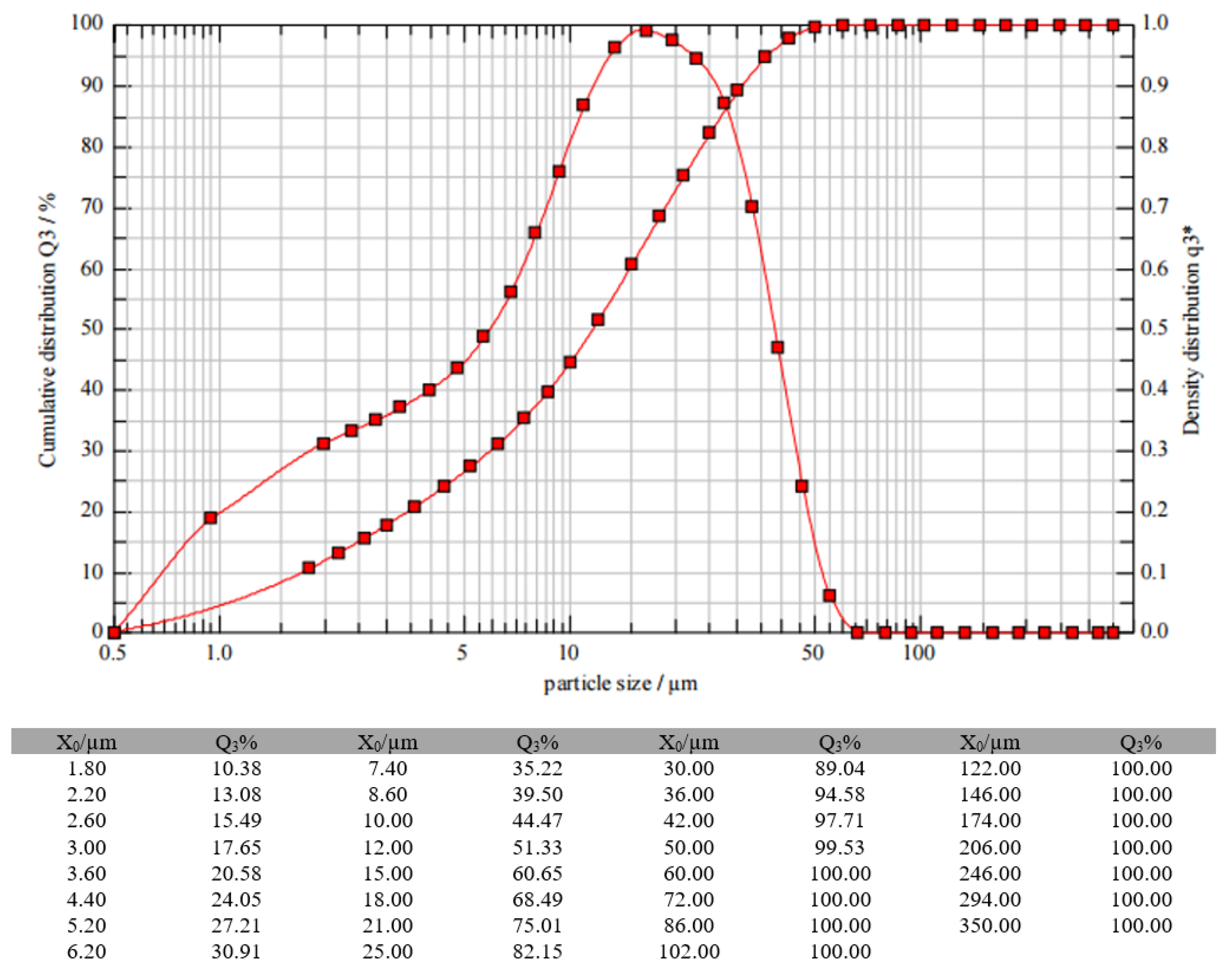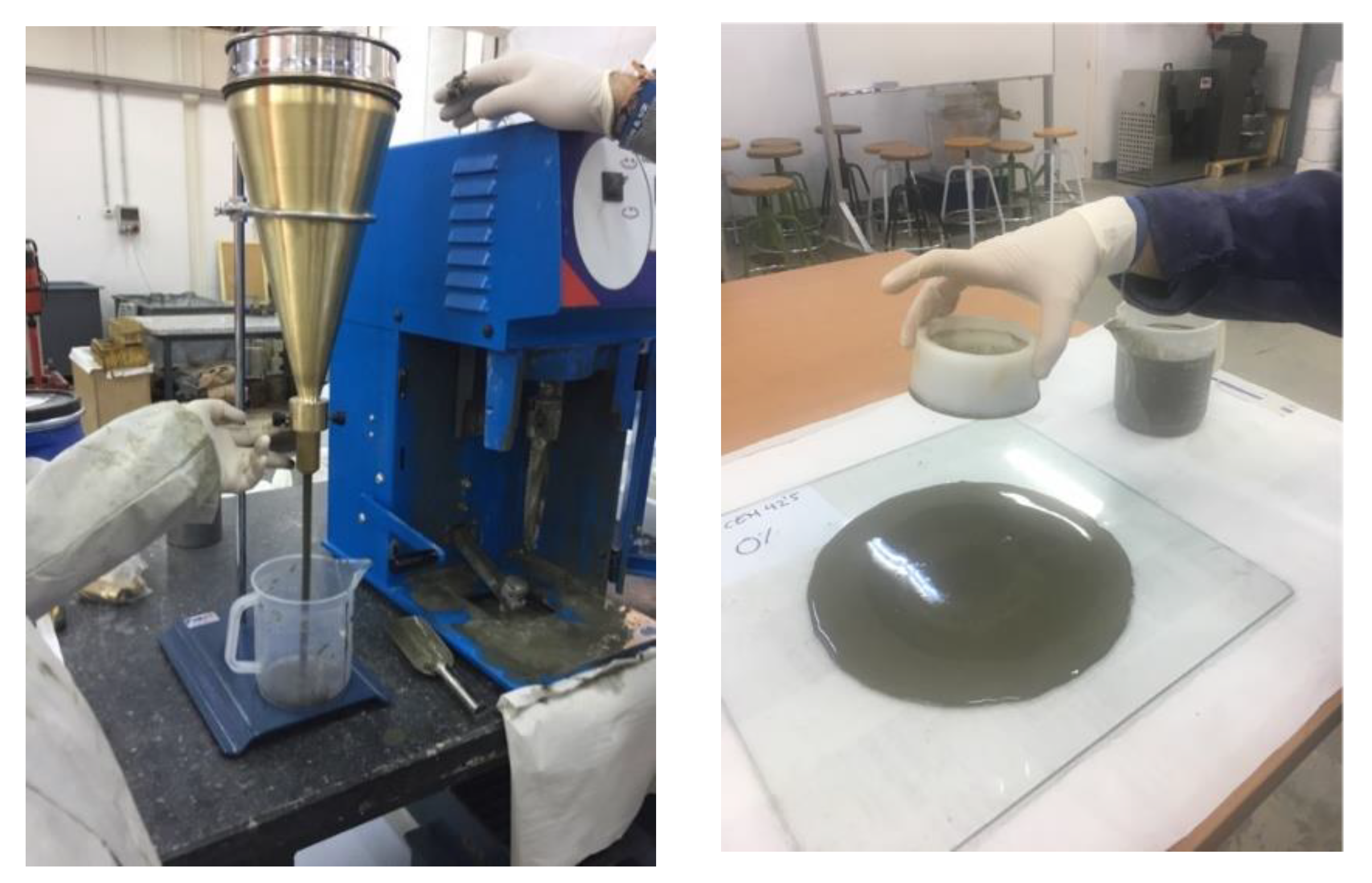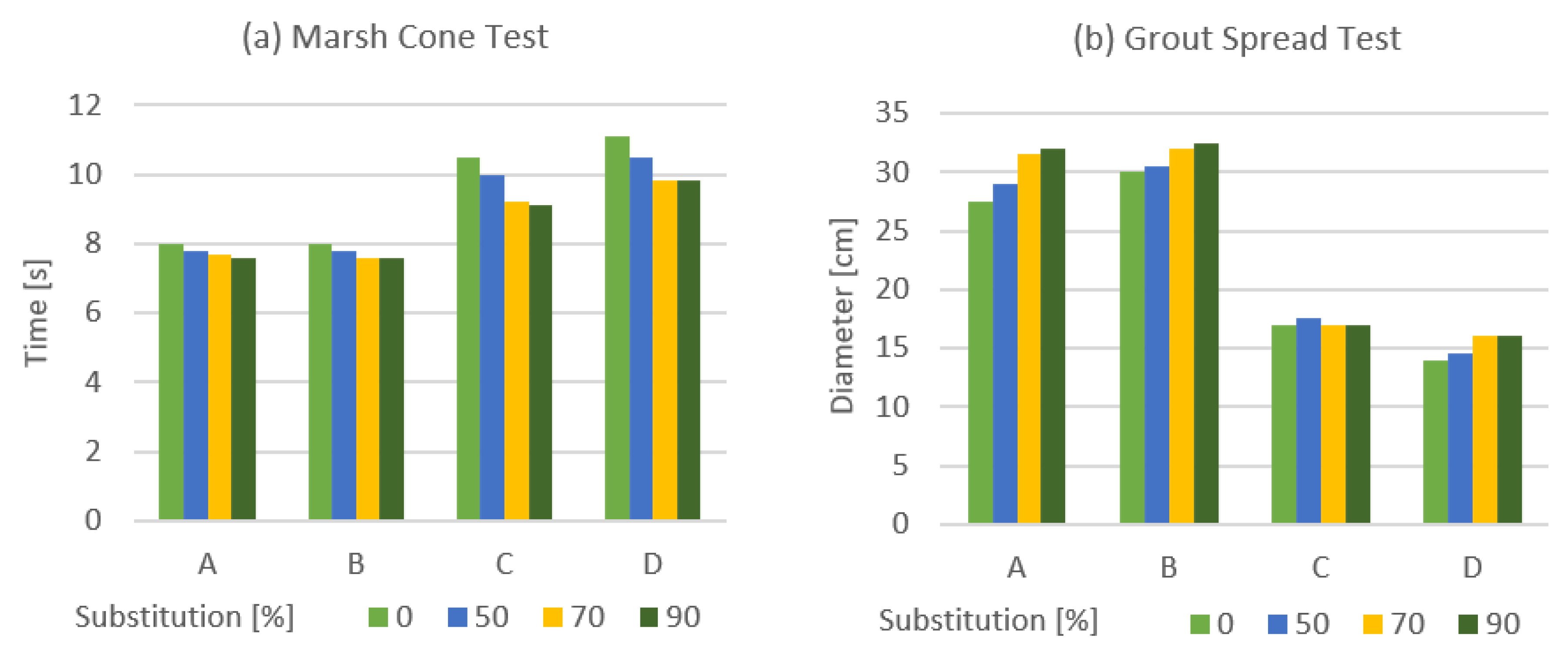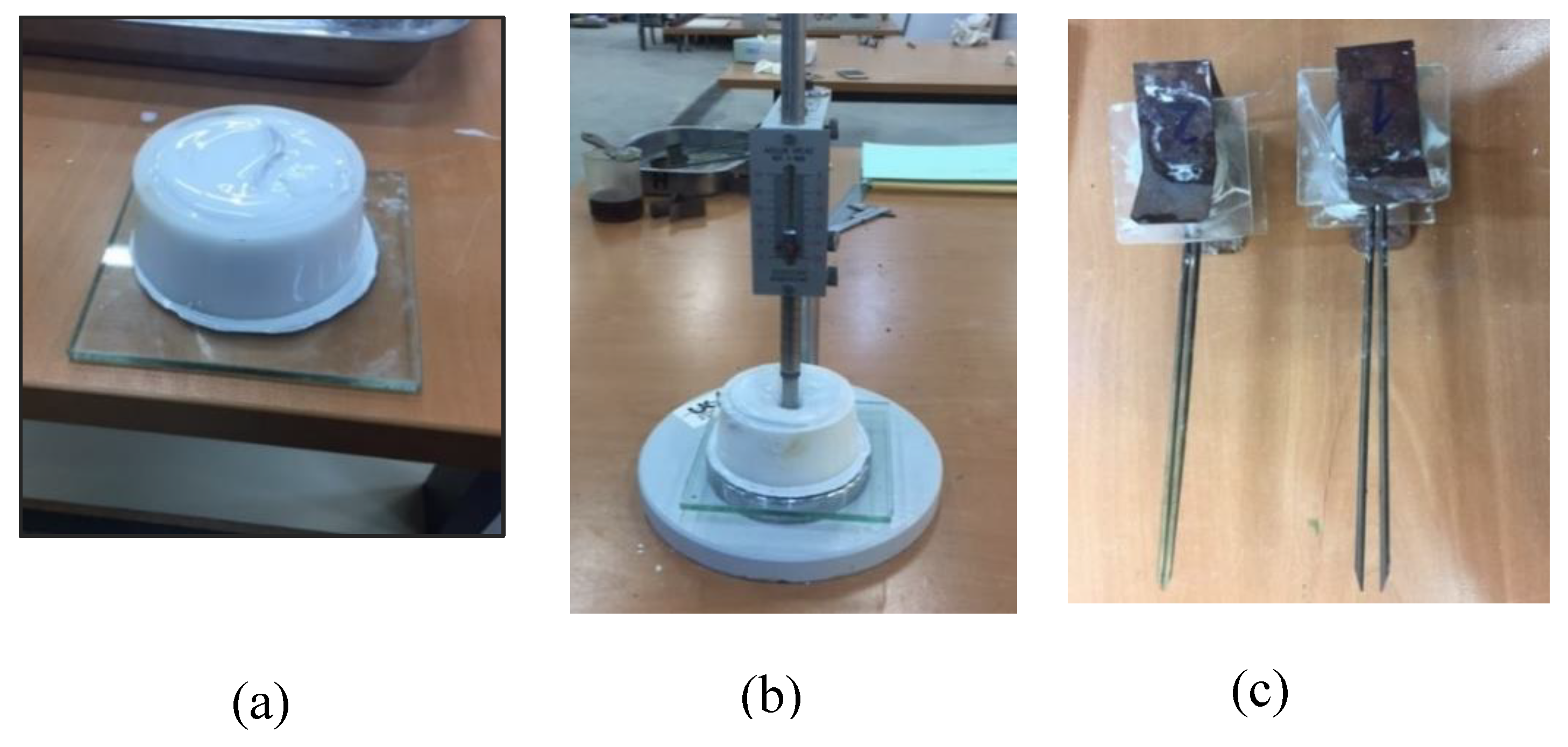Advances in the Analysis of Properties Behaviour of Cement-Based Grouts with High Substitution of Cement with Blast Furnace Slags
Abstract
:1. Introduction
2. Materials
3. Analysis of Fresh State Properties
3.1. Density
3.2. Fluidity
3.3. Exudation
4. Strength Properties
4.1. Analysis of Compressive Strength Evolution
- ✓
- The existence of slag in the mixture seems to retard the speed of compression hardening. All mixtures present lower compressive strengths in the first days. This delay is also more pronounced the higher the percentage of slags are in the mixture.
- ✓
- In general, the substitution of slag cement maintains the compressive strength of the resulting mixture in the same order of magnitude. Although it presents variations depending on the percentage and the rest of the characteristics of the mixture (type of cement and ratio w/b). In general, all mixtures are appropriate to resist these efforts in uses similar to those of the reference mixture.
- ✓
- Substitutions of 50% from day 14, the results tend to converge to the reference in all cases. This level of substitution offers us a mixture more similar to the original in terms of mechanical capacity independently of the rest of the factors analyzed.
- ✓
- When we increase the percentage, we find an increase in resistance up to 70% in all of them. From there, the behavior of up to 90% shows variations. For type A and D mixtures, 70% and 90% converge. For mixtures type B and C, however, those of 90% worsen their behavior.
- ✓
- We observe cases where we obtain considerable compression strength increases but the time to reach them are variable. A70 presents 70% more resistance. B70 also reach these values but in 90 days (off the chart of the figure). Mixtures C70 and D90 present a lower increase in a range of 35% to 50%.
4.2. Analysis of Flexural Strength Results
- ✓
- In the first days of setting, none of the mixtures with slag substitution achieves the flexural strength of the reference mixture.
- ✓
- Mixtures with 70% substitutions present the best behaviours. From this level, the mixtures tend to stabilize with somewhat lower values (B-D) or bring their resistance closer to that of reference (A-C).
- ✓
- Comparing the mixtures A and B, it can be observed, as expected, that the mixtures follow the same evolution in terms of resistance gained over time. Type B mixtures being made with 52.5 cement reaches more strength.
- ✓
- Comparing mixtures C and D, the evolution is equalized in virtually all mixtures regardless of the type of cement used. The more percentage of substitution used, the more delay in hardening in the first days of setting. In this type of mixture, a resistance gain with respect to the reference mixtures is not reflected up to 90 days.
- ✓
- Comparing mixtures A and C, Type C mixtures reflect better behaviour with respect to the flexural strength gain than type A mixtures.
- ✓
- Comparing mixtures B and D, as in the case of the comparison between mixtures type A and C, the evolution of the flexural strength gains remains unmarked.
5. Unsoundness of Slag
- A distance measurement: At the end of the 24 h ± 30 min period, the distance (A) between the needle tips is measured with an approximation of 0.5 mm. The mold is then gradually heated to boiling for 30 ± 5 min and the bath is kept at the boiling temperature for 3 h ± 5 min.
- B Distance measurement: At the end of the boiling period, the distance (B) between the needle tips can be measured with an approximation of 0.5 mm.
- C Distance measurement: The specimens are removed from the heat, and allowed to cool to the laboratory temperature. The distance (C) between the needle tips is measured with an approximation of 0.5 mm.
6. Leaching Behaviour and Environmental Influence
7. Conclusions
- Mixtures with slags are less dense than mixtures without substitution, which becomes more fluid as it increases the percentage substitution.
- In all types of mixtures, the exudation decreases with respect to the mixtures without substitution. The higher the percentage, the lower the exudation. As expected, mixtures with 1/1 water/binder ratio exudes much more than 0.67/1 ones in the order of 25%.
- Results prove a significance reduction in chemical element leaching in all the mixtures with slag substitution. The expansion is lower as well.
- The mechanical response in terms of flexion and compression strength gives better results in all types of mixtures with substitution. The hardening process of the mixture is modified and delayed. At an early stage, the resistance of the reference mixture is not reached. However, the hardening period increases and the final resistances after 90 days are obtained. Optimal mixtures are those made with the percentage of 70% substitution.
- The slower development of mechanical properties in an early age have to be considered in potential applications of these mixtures.
- Mixtures with a high percentage of substitution (90%) present an interesting behavior related to strength properties. Both cases, with CEM I 52.5R and CEM I 42.5 R cement, produce similar levels of resistance. In these study cases, the cement loses relevance with respect to slag used in terms of its mechanical characterization.
- It is also observed that the mixtures made with slag substitution and with water/binder 1/1 are the ones that offer the greatest increase of strength due to the greater hydration.
- High substitution of cement with GGBFS may lead to the problem of volume stability. It has to be properly cured.
Author Contributions
Funding
Acknowledgments
Conflicts of Interest
References
- Ámbito, E.L.; Concreto, D.E.L.; Materias, N.; En, P.; Ámbito, E.L.; Concreto, D.E.L. La “Transmutación” Sostenible de los Residuos. Dyna 2012, 79, 38–47. [Google Scholar]
- Mahasenan, N.; Smith, S.; Humphreys, K. The Cement Industry and Global Climate ChangeCurrent and Potential Future Cement Industry CO2 Emissions. In Proceedings of the 6th International Conference on Greenhouse Gas Control Technologies, Kyoto, Japan, 1–4 October 2002; pp. 995–1000. [Google Scholar]
- Benhelal, E.; Zahedi, G.; Shamsaei, E.; Bahadori, A. Global strategies and potentials to curb CO2 emissions in cement industry. J. Clean. Prod. 2013, 51, 142–161. [Google Scholar] [CrossRef]
- Chen, C.; Habert, G.; Bouzidi, Y.; Jullien, A. Environmental impact of cement production: Detail of the different processes and cement plant variability evaluation. J. Clean. Prod. 2010, 18, 478–485. [Google Scholar] [CrossRef]
- Bilim, C.; Atis, C.D. Alkali activation of mortars containing different replacement levels of ground granulated blast furnace slag. Constr. Build. Mater. 2012, 28, 708–712. [Google Scholar] [CrossRef]
- Rashad, A.M. A comprehensive overview about the influence of different additives on the properties of alkali-activated slag—A guide for Civil Engineer. Constr. Build. Mater. 2013, 47, 29–55. [Google Scholar] [CrossRef]
- Kim, J.-H.; Lee, H.-S. Improvement of Early Strength of Cement Mortar Containing Granulated Blast Furnace Slag Using Industrial Byproducts. Materials 2017, 10, 1050. [Google Scholar] [CrossRef] [Green Version]
- Fonseca, F.S.; Godfrey, R.C.; Siggard, K. Compressive strength of masonry grout containing high amounts of class F fly ash and ground granulated blast furnace slag. Constr. Build. Mater. 2015, 94, 719–727. [Google Scholar] [CrossRef]
- Parron-Rubio, M.E.; Perez-García, F.; Gonzalez-Herrera, A.; Rubio-Cintas, M.D. Concrete properties comparison when substituting a 25% cement with slag from different provenances. Materials 2018, 11, 1029. [Google Scholar] [CrossRef] [Green Version]
- Pereira, C.F.; Galiano, Y.L.; Rodríguez-Piñero, M.; Parapar, J.V. Long and short-term performance of a stabilized/solidified electric arc furnace dust. J. Hazard. Mater. 2007, 148, 701–707. [Google Scholar] [CrossRef]
- Loaiza, A.; Cifuentes, S.; Colorado, H.A. Asphalt modified with superfine electric arc furnace steel dust (EAF dust) with high zinc oxide content. Constr. Build. Mater. 2017, 145, 538–547. [Google Scholar] [CrossRef]
- Brehm, F.A.; Moraes, C.A.M.; Modolo, R.C.E.; Vilela, A.C.F.; Molin, D.C.C.D. Oxide zinc addition in cement paste aiming electric arc furnace dust (EAFD) recycling. Constr. Build. Mater. 2017, 139, 172–182. [Google Scholar] [CrossRef]
- Amahjour, F.; Pardo, P.; Borrachero, M.V. Propiedades De Lechadas De Cemento Fabricadas Con Cementos De Tipo I Y Mezclas Con Cenizas Volantes (Cv)Y Humo De Sílice (Hs). VIII Congr. Nac. Prop. Mec. Solidos 2002, 1, 729–737. [Google Scholar]
- Pastor, J.L.; Ortega, J.M.; Flor, M.; López, M.P.; Sánchez, I.; Climent, M.Á. Microstructure and durability of fly ash cement grouts for micropiles. Constr. Build. Mater. 2016, 117, 47–57. [Google Scholar] [CrossRef] [Green Version]
- Çelik, F.; Canakci, H.; Çanakcı, H. An investigation of rheological properties of cement-based grout mixed with rice husk ash (RHA). Constr. Build. Mater. 2015, 91, 187–194. [Google Scholar] [CrossRef]
- Cheah, C.B.; Tiong, L.L.; Ng, E.P.; Oo, C.W. The engineering performance of concrete containing high volume of ground granulated blast furnace slag and pulverized fly ash with polycarboxylate-based superplasticizer. Constr. Build. Mater. 2019, 202, 909–921. [Google Scholar] [CrossRef]
- Zhang, W.; Li, S.; Wei, J.; Zhang, Q.; Liu, R.; Zhang, X.; Yin, H. Grouting rock fractures with cement and sodium silicate grout. Carbonates Evaporites 2018, 33, 211–222. [Google Scholar] [CrossRef]
- Azadi, M.R.; Taghichian, A.; Taheri, A. Optimization of cement-based grouts using chemical additives. J. Rock Mech. Geotech. Eng. 2017, 9, 623–637. [Google Scholar] [CrossRef]
- Gopinathan, S.; Anand, K.B. Properties of cement grout modified with ultra-fine slag. Front. Struct. Civ. Eng. 2018, 12, 58–66. [Google Scholar] [CrossRef]
- Sanderson, R.A.; Cann, G.M.; Provis, J.L. The effect of blast-furnace slag particle size on the hydration of slag-Portland cement grouts at elevated temperatures. Advances Cement Res. 2018, 30, 337–344. [Google Scholar] [CrossRef]
- Joshaghani, A.; Moeini, M.A.; Balapour, M.; Moazenian, A. Effects of supplementary cementitious materials on mechanical and durability properties of high-performance non-shrinking grout (HPNSG). J. Sustain. Cem. Mater. 2018, 7, 38–56. [Google Scholar] [CrossRef]
- Sha, F.; Li, S.; Liu, R.; Li, Z.; Zhang, Q. Experimental study on performance of cement-based grouts admixed with fly ash, bentonite, superplasticizer and water glass. Constr. Build. Mater. 2018, 161, 282–291. [Google Scholar] [CrossRef]
- Cui, J.; Zhang, W.; Ji, X.; Ji, G.-A. Study on performance of fly ash slag cement grouting materials. IOP Conf. Ser. Earth Environ. Sci. 2019, 267, 032012. [Google Scholar] [CrossRef]
- Mukherjee, D.; Sahoo, U.C. Laboratory characterization of a cement grouted bituminous macadam made with Portland slag cement. Int. J. Pavement Res. Technol. 2019, 12, 574–580. [Google Scholar] [CrossRef]
- Li, Z.; Zhang, J.; Li, S.; Gao, Y.; Liu, C.; Qi, Y. Effect of different gypsums on the workability and mechanical properties of red mud-slag based grouting materials. J. Clean. Prod. 2020, 249, 118759. [Google Scholar] [CrossRef]
- Xiang, J.; Liu, L.; He, Y.; Zhang, N.; Cui, X. Early mechanical properties and microstructural evolution of slag/metakaolin-based geopolymers exposed to karst water. Cem. Concr. Compos. 2019, 99, 140–150. [Google Scholar] [CrossRef]
- Rubio-Cintas, M.; Barnett, S.; Perez-García, F.; Parron-Rubio, M. Mechanical-strength characteristics of concrete made with stainless steel industry wastes as binders. Constr. Build. Mater. 2019, 204, 675–683. [Google Scholar] [CrossRef] [Green Version]
- Perez-Garcia, F.; Parron-Rubio, M.E.; Garcia-Manrique, J.M.; Rubio-Cintas, M.D. Study of the Suitability of Different Types of Slag and Its Influence on the Quality of Green Grouts Obtained by Partial Replacement of Cement. Materials 2019, 12, 1166. [Google Scholar] [CrossRef] [PubMed] [Green Version]
- Parron-Rubio, M.E.; Perez-Garcia, F.; Gonzalez-Herrera, A.; Oliveira, M.J.; Rubio-Cintas, M.D. Slag Substitution as a Cementing Material in Concrete: Mechanical, Physical and Environmental Properties. Materials 2019, 12, 2845. [Google Scholar] [CrossRef] [Green Version]
- European Comittee for Standardization EN 197-1:2011Cement—Part 1: Composition, Specifications and Conformity Criteria for Common Cements; Aenor: Madrid, Spain, 2011.
- European Comittee for Standardization EN 447: 2009 Grout for Prestressing Tendons; Basic requirements; Aenor: Madrid, Spain, 2009.
- European Comittee for StandarDization EN 196-1:2005 Methods of Testing Cement; Determination of strength; Aenor: Madrid, Spain, 2005.
- European Comittee for Standardization EN 445: 20011 Grout for Prestressing Tendons; Test Methods; Aenor: Madrid, Spain, 2009.
- European Comittee for Standardization EN 196-7:2008 Methods of Testing Cement—Part 7: Methods of Taking and Preparing Samples of Cement; Aenor: Madrid, Spain, 2008.
- European Comittee for Standardization En 196-3:2017 Methods of Testing cement—Part 3: Determination of Setting Times and Soundness; Aenor: Madrid, Spain, 2017.
- European Comittee for Standardization EN 14405-1:2018 Geometrical Product Specifications (GPS)—Dimensional Tolerancing—Part 1: Linear Sizes; Aenor: Madrid, Spain, 2018.









| Oxides | CEM I 42.5 and 52.5 Composition (%) | GGBFS Composition (%) |
|---|---|---|
| CaO | 63.56 | 47.14 |
| SiO2 | 19.30 | 32.30 |
| SO3 | 2.91 | 1.52 |
| Al2O3 | 5.57 | 8.90 |
| Fe2O3 | 3.46 | 0.29 |
| MgO | 0.86 | 7.64 |
| K2O | 0.80 | 0.45 |
| Na2O | 0.13 | 0.08 |
| Other (ZnO, MnO, ZrO2, …) | 3.41 | 1.97 |
| Series | Id | Mix Composition | ||
|---|---|---|---|---|
| w/b | Cement | GGBFS (%) | ||
| A | A0 | 1/1 | 42.5 | 0 |
| A50 | 1/1 | 42.5 | 50 | |
| A70 | 1/1 | 42.5 | 70 | |
| A90 | 1/1 | 42.5 | 90 | |
| B | B0 | 1/1 | 52.5R | 0 |
| B50 | 1/1 | 52.5R | 50 | |
| B70 | 1/1 | 52.5R | 70 | |
| B90 | 1/1 | 52.5R | 90 | |
| C | C0 | 0.67/1 | 42.5 | 0 |
| C50 | 0.67/1 | 42.5 | 50 | |
| C70 | 0.67/1 | 42.5 | 70 | |
| C90 | 0.67/1 | 42.5 | 90 | |
| D | D0 | 0.67/1 | 52.5R | 0 |
| D50 | 0.67/1 | 52.5R | 50 | |
| D70 | 0.67/1 | 52.5R | 70 | |
| D90 | 0.67/1 | 52.5R | 90 | |
| % Mix ID | A | B | C | D |
|---|---|---|---|---|
| 0 | 1.47 | 1.44 | 1.82 | 1.77 |
| 50 | 1.44 | 1.45 | 1.79 | 1.75 |
| 70 | 1.46 | 1.40 | 1.77 | 1.74 |
| 90 | 1.42 | 1.40 | 1.76 | 1.72 |
| Days | 2 | 4 | 7 | 14 | 28 | 90 | Increase with Respect to Reference | |
|---|---|---|---|---|---|---|---|---|
| Mixture | ||||||||
| 0A | 1.61 | 2.11 | 2.45 | 2.86 | 3.35 | 3.92 | - | |
| 50A | 0.94 | 1.39 | 1.65 | 2.41 | 3.46 | 4.63 | 18.11% | |
| 70A | 0.69 | 1.57 | 2.22 | 2.55 | 3.34 | 4.72 | 20.41% | |
| 90A | 0.44 | 0.98 | 1.44 | 2.03 | 2.94 | 4.05 | 3.32% | |
| 0B | 2.68 | 3.14 | 3.51 | 4.78 | 5.21 | 5.46 | - | |
| 50B | 0.96 | 1.96 | 2.94 | 3.89 | 4.35 | 5.98 | 9.52% | |
| 70B | 0.78 | 1.75 | 2.67 | 4.01 | 4.96 | 6.2 | 13.55% | |
| 90B | 0.51 | 1.36 | 2.16 | 3.55 | 3.28 | 6.12 | 12.09% | |
| 0C | 3.36 | 3.54 | 3.92 | 5.3 | 6.23 | 6.54 | - | |
| 50C | 1.66 | 2.77 | 3.51 | 4.58 | 5.38 | 6.8 | 3.98% | |
| 70C | 1.2 | 2.08 | 3.3 | 4.21 | 5.69 | 7.45 | 13.91% | |
| 90C | 0.46 | 1.75 | 2.03 | 4.44 | 4.77 | 6.76 | 3.36% | |
| 0D | 4.55 | 5.13 | 5.4 | 5.67 | 6.09 | 7.03 | - | |
| 50D | 2.38 | 3.84 | 4.24 | 4.76 | 5.69 | 7.49 | 6.54% | |
| 70D | 1.66 | 3.14 | 3.23 | 5.06 | 6.4 | 8.02 | 14.08% | |
| 90D | 0.61 | 1.4 | 1.95 | 4.43 | 6.03 | 7.63 | 8.53% | |
| Cement-Based Paste | GGBS-Based Paste | |||||||
|---|---|---|---|---|---|---|---|---|
| A (mm) | B (mm) | C (mm) | C-A (mm) | A (mm) | B (mm) | C (mm) | C-A (mm) | |
| Specimen 1 | 7 | 8.2 | 9 | 2 | 7 | 7.5 | 7.5 | 0.5 |
| Specimen 2 | 10 | 12.4 | 13 | 3 | 8 | 8.5 | 8.5 | 0.5 |
| Components | Water Exudation from B0 (mg/L) | Water Exudation from B70 (mg/L) | B0 Mix (mg/L) | B0 Mix (mg/kg) | B70 Mix (mg/L) | B70 Mix (mg/kg) | Reference from EN-14405 (mg/kg) | Percolation mg/L |
|---|---|---|---|---|---|---|---|---|
| weight (kg) | 0.35 | 0.35 | 0.35 | 0.35 | ||||
| [Na] mg/L | 680 | 336 | 11.6 | 33.1429 | 4.51 | 12.8857 | - | - |
| [K] mg/L | 5780 | 2872 | 47.8 | 136.5714 | 20.2 | 57.7143 | - | - |
| [Ca] mg/L | 571 | 805 | 185 | 528.5714 | 4.73 | 13.5143 | - | - |
| [Mg]mg/L | 0.014 | 0.021 | 0.0202 | 0.0577 | 0.076 | 0.2171 | - | - |
| [Al] mg/L | 0.001 | 0.0029 | 0.17 | 0.4857 | 0.703 | 2.0086 | - | - |
| [Si]mg/L | 0.013 | 0.011 | 0.0086 | 0.0246 | 0.044 | 0.1257 | - | - |
| [Ti] mg/L | < 0.0001 | < 0.0001 | < 0.0001 | - | < 0.0001 | - | - | - |
| [Cr] mg/L | 1.23 | 0.853 | 0.015 | 0.0429 | 0.00016 | 0.0005 | 0.5 | 0.1 |
| [Mn] mg/L | 0.0001 | 0.0003 | 0.0001 | 0.0003 | 0.00068 | 0.0019 | - | - |
| [Fe] mg/L | 0.001 | 0.0023 | 0.0182 | 0.0520 | 0.006 | 0.0171 | - | - |
| [Ni] mg/L | 0.00029 | 0.00017 | 0.00027 | 0.0008 | 0.000174 | 0.0005 | 0.4 | 0.12 |
| [Cu] mg/L | 0.00413 | 0.0031 | 0.00192 | 0.0055 | 0.0045 | 0.0129 | 2 | 0.6 |
| [Zn] mg/L | 0.0021 | 0.00089 | 0.0066 | 0.0189 | 0.000694 | 0.0020 | 4 | 1.2 |
| [As] mg/L | 0.000541 | 0.00039 | < 0.0002 | - | 0.00033 | 0.0009 | 2 | 0.06 |
| [Cd] mg/L | < 0.0001 | < 0.0001 | < 0.0001 | - | < 0.0001 | - | 1 | 0.02 |
| [Sn] mg/L | < 0.0001 | < 0.0001 | < 0.0001 | - | < 0.0001 | - | - | - |
| [Pb] mg/L | 0.0082 | 0.002 | 0.000543 | 0.0016 | < 0.0001 | - | 0.5 | 0.15 |
© 2020 by the authors. Licensee MDPI, Basel, Switzerland. This article is an open access article distributed under the terms and conditions of the Creative Commons Attribution (CC BY) license (http://creativecommons.org/licenses/by/4.0/).
Share and Cite
Perez-Garcia, F.; Rubio-Cintas, M.D.; Parron-Rubio, M.E.; Garcia-Manrique, J.M. Advances in the Analysis of Properties Behaviour of Cement-Based Grouts with High Substitution of Cement with Blast Furnace Slags. Materials 2020, 13, 561. https://doi.org/10.3390/ma13030561
Perez-Garcia F, Rubio-Cintas MD, Parron-Rubio ME, Garcia-Manrique JM. Advances in the Analysis of Properties Behaviour of Cement-Based Grouts with High Substitution of Cement with Blast Furnace Slags. Materials. 2020; 13(3):561. https://doi.org/10.3390/ma13030561
Chicago/Turabian StylePerez-Garcia, Francisca, Maria Dolores Rubio-Cintas, Maria Eugenia Parron-Rubio, and Jose Manuel Garcia-Manrique. 2020. "Advances in the Analysis of Properties Behaviour of Cement-Based Grouts with High Substitution of Cement with Blast Furnace Slags" Materials 13, no. 3: 561. https://doi.org/10.3390/ma13030561
APA StylePerez-Garcia, F., Rubio-Cintas, M. D., Parron-Rubio, M. E., & Garcia-Manrique, J. M. (2020). Advances in the Analysis of Properties Behaviour of Cement-Based Grouts with High Substitution of Cement with Blast Furnace Slags. Materials, 13(3), 561. https://doi.org/10.3390/ma13030561






